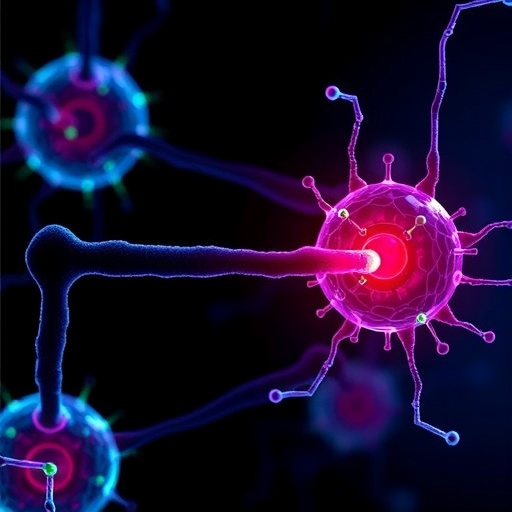In a groundbreaking discovery poised to reshape our understanding of cellular death mechanisms, researchers at the Technical University of Munich (TUM) have identified a novel molecular switch regulating apoptosis—the programmed cell death essential for maintaining cellular health and homeostasis. The study, spearheaded by Prof. Franz Hagn’s team at the Chair of Structural Membrane Biochemistry, unveils how the mitochondrial voltage-dependent anion channel protein (VDAC1) directly interacts with the apoptosis inhibitor Bcl-xL, providing an unprecedented insight into the balance between cell survival and death.
Apoptosis is a highly efficient and evolutionarily honed process crucial for eliminating damaged or potentially dangerous cells without triggering inflammation. Central to this regulation is the mitochondrion, often described as the cell’s powerhouse. This organelle not only supplies energy but also integrates signaling pathways that dictate cell fate. The research team has uncovered how VDAC1, localized in the outer mitochondrial membrane, acts as a molecular lever that can override the inhibitory effects of Bcl-xL, releasing the cellular brakes on apoptosis during times of cellular stress.
At the core of this regulatory mechanism lies a structural metamorphosis of VDAC1 triggered by increased mitochondrial stress—a condition often signaling abnormal cellular function or DNA damage. Using cutting-edge techniques including nuclear magnetic resonance (NMR) spectroscopy, X-ray crystallography, and cryo-electron microscopy, the researchers captured VDAC1 in states before and after this conformational shift. Their data reveal that VDAC1 unfolds a specific segment of its structure, enabling direct binding to Bcl-xL. This interaction effectively deactivates Bcl-xL’s inhibitory role, thereby facilitating the apoptotic cascade.
The ability of VDAC1 to modulate Bcl-xL’s function represents a strategic checkpoint in apoptosis, which until now has been elusive. Bcl-xL acts as a safeguard, preventing inadvertent activation of cell death under normal physiological conditions. The implication that VDAC1 can structurally and functionally nullify this safety mechanism adds a new layer of complexity to mitochondrial regulation and cell fate determination.
Dr. Umut Günsel and Dr. Melina Daniilidis, co-first authors of this influential study, emphasized the integrative approach employed. By combining high-resolution structural data with complementary biochemical assays, they delineated the specific interactions between VDAC1 and Bcl-xL at atomic detail. These insights not only clarify how mitochondrial stress signals are transduced but also highlight potential molecular targets for therapeutic intervention.
The clinical implications stemming from this discovery are vast and significant. Cancer cells frequently evade apoptosis, enabling unchecked proliferation. Therapeutic strategies enhancing VDAC1 activation could tip the balance toward cell death in tumor cells, providing a novel and potentially powerful approach to cancer treatments. Conversely, in neurodegenerative disorders such as Alzheimer’s and Parkinson’s diseases, where undesired apoptosis contributes to neuron loss, strategies to inhibit this VDAC1-driven pathway may help preserve neural function.
Beyond oncology and neurology, the modulation of this apoptotic switch holds promise for cardiovascular diseases. In ischemia-reperfusion injury, which damages myocardial tissue following restored blood flow after a heart attack, preventing excessive apoptosis through targeted VDAC1 inhibition could reduce cell death and improve patient outcomes. These prospects underscore the translational potential of the research, though the path to viable therapeutic agents remains in its infancy.
Despite the enthusiastic outlook, the researchers caution that the journey from mechanistic insight to medical application is complex and uncertain. The identification of small molecules or biologics that precisely modulate VDAC1’s activation state demands extensive screening and optimization. Furthermore, the systemic effects of manipulating apoptosis pathways must be carefully evaluated to avoid inadvertent toxicity or adverse effects.
This landmark study represents a culmination of interdisciplinary efforts combining structural biology, biochemistry, and cellular physiology. It exemplifies how understanding the structural underpinnings of molecular interactions within mitochondria can illuminate fundamental biological processes and inspire innovative drug discovery avenues. As Prof. Hagn notes, nature’s evolutionary refinements provide a blueprint for designing interventions that harness intrinsic cellular mechanisms rather than imposing artificial constructs.
The research, published in the prestigious journal Nature Communications, provides a new structural framework for studying mitochondrial apoptosis, one of the most critical processes in cellular biology. The DOI link offers direct access to the full article for those interested in exploring the detailed experimental protocols and datasets underlying these findings.
In summary, the discovery of VDAC1’s role as a structural and functional antagonist to Bcl-xL-mediated inhibition marks a paradigm shift in our understanding of apoptosis regulation. It opens exciting prospects for the rational design of next-generation therapies aimed at manipulating cell death in diverse pathological contexts, from cancer to neurodegeneration and cardiovascular diseases. This study stands as a beacon demonstrating the power of structural biochemistry to illuminate and ultimately control life’s most fundamental processes.
Subject of Research: Not applicable
Article Title: Structural basis of apoptosis induction by the mitochondrial voltage-dependent anion channel
News Publication Date: 27-Oct-2025
Web References:
http://dx.doi.org/10.1038/s41467-025-65363-1
References:
Melina Daniilidis, Umut Günsel, Robert Janowski, Kai Fredriksson, Georgios Broutzakis, Kira D. Leitl, Dierk Niessing, Christos Gatsogiannis, and Franz Hagn: Structural basis of apoptosis induction by the mitochondrial voltage-dependent anion channel, Nature Communications, October 27, 2025.
Keywords: apoptosis, VDAC1, Bcl-xL, mitochondria, cell death regulation, structural biology, nuclear magnetic resonance, X-ray crystallography, cryo-electron microscopy, cancer therapy, neurodegenerative diseases, ischemia-reperfusion injury
Tags: apoptosis and inflammation connectionapoptosis regulation insightsBcl-xL interaction with VDAC1cellular homeostasis and survivalcellular stress response mechanismsmitochondrial dysfunction and diseasemitochondrial voltage-dependent anion channelnovel molecular switch discoveryprogrammed cell death mechanismsrole of apoptosis in cellular healthstructural biochemistry of mitochondriaTUM research on cell death





